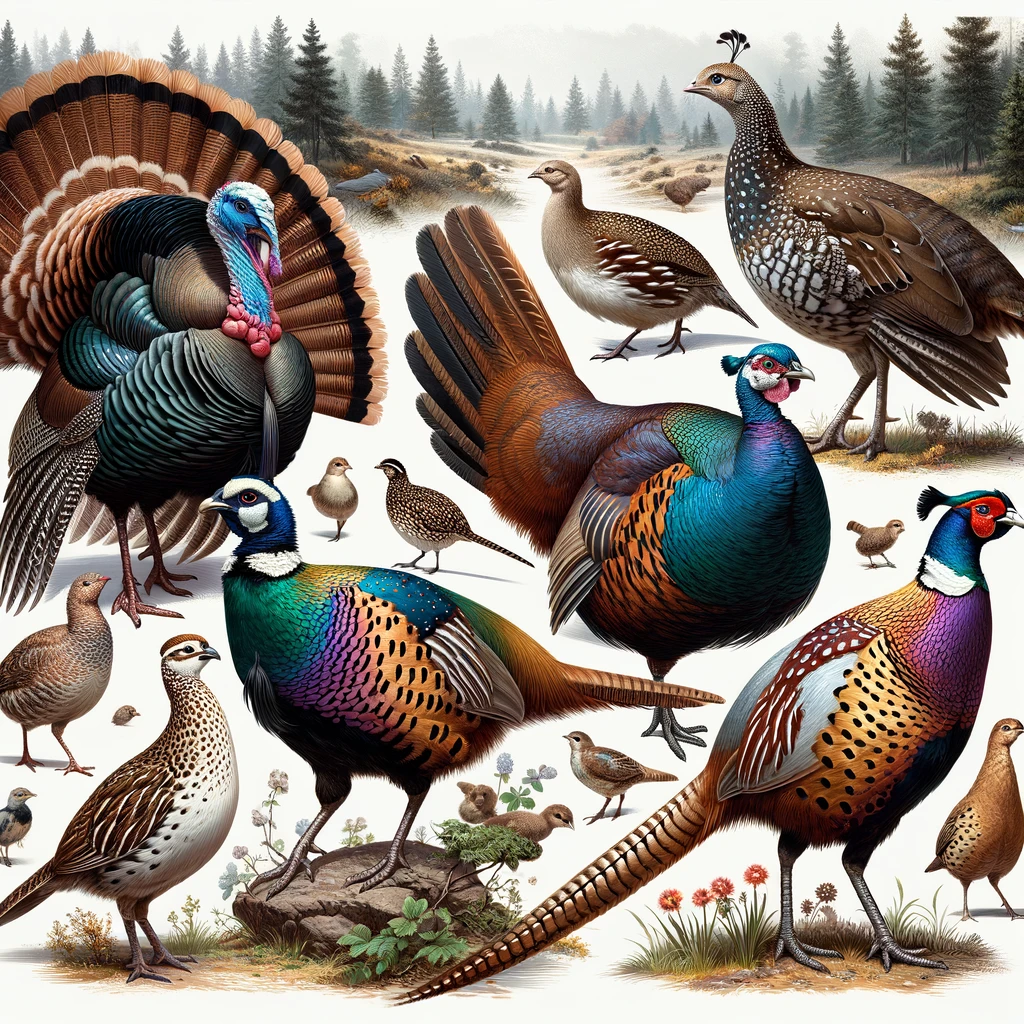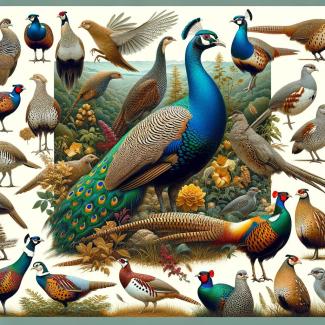
Encompassing a variety of heavy-bodied, ground-dwelling birds like pheasants, grouse, quail, chickens, and turkeys, Galliformes is a diverse order of omnivorous and herbivorous species well-adapted to terrestrial living. With over 290 species, Galliformes live on every continent except Antarctica and have been domesticated by humans for thousands of years.
The evolutionary origins of ancestral galliforms can be traced back to the late Cretaceous period over 65 million years ago alongside early waterfowl and gamebird ancestors. From ground-feeding generalized forms emerged an explosive Paleogene radiation centered across the ancient supercontinent of Laurasia which helped launch diverse partridge, pheasants, and grouse lineages.
Later continental colonization waves transferred certain genera as South America and Australia separated while climate shifts selected cold-hardy species giving rise to ptarmigan and prairie chicken groups across higher latitudes. Diversification stalled somewhat as extensive open country niches filled but localized tropical speciation continues evolving unique taxa across remaining isolated habitats.
Today Galliformes remain largely tied to their ancestral scrubland and forest edge ancestries even as some have adapted towards extreme environments from the snow line to McIlhenny's partridges dodging jaguars in isolated Central American mountains.
Characteristics
Physical Features
Galliformes range dramatically in size from the diminutive 100 gram Painted quails of Latin America to imposing 4.5 kilogram wild turkeys and Western capercaillie grouse in North America and Eurasia respectively. Overall, however, medium proportions of 25 to 75-centimeter bodies prevail across most species besides domestic breeds.
A shared squat profile hugs the terrestrial habitat thanks to a short, thick neck transitioning into an especially dense muscular breast area facilitating rapid bursts exploding outward when disturbed. Wings remain rounded to support the brief buoyant flight necessary to reach traditional roosting trees or escape surprise attacks.
Identification of Galliformes often relies upon striking sexual dichromatism patterns used in courtship displays like iridescent throat bristles.
The defining galliform trait though remains intricate toe and toe claw arrangements that provide balance and traction walking across variable surfaces while also proving essential for rapid excavation abilities to access subterranean beetles, insect larvae, and worms when protein requires supplementation amidst herbivorous browsing.
Behavioral Traits
Primarily herbivorous, Galliformes consume a variety of seeds, nuts, berries, leaves, buds, and some insect prey. Thick muscular gizzards efficiently grind fibrous plant material. Energetic feeding requirements to sustain bulk and activity spur social tolerance and flock formation centered around rich food patches.
Yet territorial behavior still manifests in spring mating arenas as spectacular males like prairie chickens congregate to stamp grounds and spar - attempting to lure and dominate harems with ostentatious displays. Courtship rituals also encompass elaborate acts like drumming logs and glossy feather erection extensions.
Reproduction and Lifespan
Reproduction peaks amidst such brief seasonal windows timed with habitat productivity optimizing survival prospects. Promiscuous mating systems see dominant cocks fertilizing multiple hen clutches. Simple ground nest scrapes amidst thickets shelter elaborate 10-15 egg broods for 3-week incubation spans.
Soon mobile precocial chicks feed independently while guarded by vigilant mothers. Sexual maturity onsets within the first year for quail while late-successional galliforms like peafowl and pheasants take 2-3 years to acquire dazzling courting suites once juveniles settle territories through dispersal wanderings. Average adult lifespans range only 3 to 5 years.
Extant Families
Phasianidae (pheasants, partridges, turkeys)
With over 180 species, Phasianidae represents the largest Galliformes family containing pheasants, junglefowl, turkeys, Old World partridges, and francolins across Eurasia and Africa. As such they establish the characteristic galliform body plan. Males demonstrate elaborate plumage and breeding displays along with spurs used in territorial fights.
Numididae (guineafowl)
The 6 guineafowl species occupy African scrublands. While they retain pheasant ecological equivalents and traits like seasonal bare facial wattles, spotted gray plumage patterns distinguish these social flocking species adapted towards more open dry habitats.
Odontophoridae (New World quail)
The two dozen species of smaller, plumper New World quails demonstrate shared galliform traits but occupy Neotropical forest and grassland floors below more dazzling relatives, Concentrated in Central America and northern South America, diminutive quails hide in plain sight amidst foliage.
Cracidae (chachalacas, guans, curassows)
This Neotropical family of large forest galliforms contains over 50 species displaying unique evolutionary departures like arboreal habits suiting tropical rainforest floors from Mexico through Argentina. Ranging dramatically in size and elaborate facial ornaments, these underappreciated birds fill galliform roles below overlapping canopies.
Global Distribution and Habitat
With over 280 species across 4 families, Galliformes enjoy extensive contemporary distribution across most temperate and tropical regions beyond extreme deserts and the High Arctic. Scattered oceanic islands also host isolated endemic forms like New Caledonia’s cagous.
Dual epicenters of Old World and New World speciation facilitated by ancient Pangean rifting events now intermix inventories thanks to introduction efforts transplanting pheasants and turkeys for sporting hunting across Europe, Asia, and the Americas alike historically alongside conquest trade expansions. Thereby most continents support both native and non-native lineages today.
Most Galliformes strongly affiliate with wooded habitats interspersed by open clearings whether tropical forests or northern conifer stands. Successional mosaics nourish browsing adults while providing protective cover shielding ground nest sites and diminutive young chicks during daily foraging bouts when families abandon the main flock temporarily.
Without extensive open terrain and adjacent escape cover, few gallinaceous forms persist outside of domestic lines bred for decreased vigilance.
Accordingly, pheasants thrive across Asia’s wooded foothills just as 3 Perdix partridge species compartmentalize European farm woods and hedgerows through partitioning seasonal elevational movements up and down montane slopes. Thereby galliforms flourish inside transitional spaces.
Ecological Importance
As abundant ground foragers across forest and savanna ecosystems, Galliformes provide essential seed dispersal and soil cultivation services benefiting myriad trees and shrubs fortifying preferred browse. Regurgitating and defecating abundant undamaged seeds, pheasants and quail may traverse kilometers daily - spreading favored plant reproductive stock far beyond original thickets.
Voracious digging for subterranean food also aerates and mixes wide swaths of soil supporting enhanced floral growth and intricate soil ecology. And leftover pits later collect rainfall nourishing tree saplings taking root within fertile microsites. Thereby they enhance forest regeneration and expansion processes over time.
Galliformes additionally serve as a consistent prey buffer stock and protein subsidy for myriad mammals and birds relying on abundant game birds to sustain faster reproductive rates historically. From foxes to wild cats and Accipiter hawks, many mesopredators depend upon galliform abundance allowing their niche viability.
During extreme winters the buffer also prevents alternative prey depletion that might destabilize communities when climatic events temporarily limit resources.
Thereby these outwardly innocuous ground birds provide essential stability mechanisms across forest and old field successional ecosystems where they concentrate living mineral richness and reproductive propagule pressure through digging feet making subtle yet invaluable contributions below overt appearance.
Galliformes in Nepal
Nepal’s subtropical lowlands and temperate middle mountain slopes sustain over 30 Galliformes species - ranging from Himalayan monal pheasants dodging through rhododendron thickets to rampant red junglefowl scratching across scattered villages nationwide.
Five species of pheasant alongside four hill partridges span the middle woodlands strata between 1,000 to 3,000-meter elevation gradients. While periodic irruptions boost local abundances, most remain common within suitable forest floors up to treeline limits.
The endangered cheer pheasant struggles from excessive historical trapping and habitat pressures across its isolated Western Himalayan range extent.
Beyond ecological stability, vibrant galliforms deliver substantial economic and cultural benefits across Nepal’s extensive rural hinterlands through sustainable community hunting opportunities focused around traditional harvests versus extensive livestock conflicts jeopardizing sympatric species like snowcocks and tragopans.
Ensuring intact forest canopies promises to uphold vibrant Galliformes heritage within Nepali forests for generations ahead.
Conservation Challenges and Efforts
While many galliform species remain abundant within suitable forest and old field habitats, increasing habitat pressures have pushed over 75 species onto threatened or near threatened conservation status lists - including endangered Edwards's pheasants of China struggling with subtropical forest fragmentation.
As ground-nesters, galliforms face acute threats from deforestation and conversion of successional scrub habitats for intensive farming and development - compromising shelter and protein-rich feeding grounds essential for reproduction.
Commercial overharvesting and relaxed hunting laws also pressure local populations already facing predation from booming mesopredator numbers near human settlements. Genetic risks accrue through extensive captive breeding and domestication.
However, concerted conservation initiatives gain momentum to reverse deterioration trends before additional species decline. Habitat restoration around protected forest reserves enhances natural pheasant dispersal and range continuity.
Closed hunting seasons and daily bag limits help counter overexploitation while community ranching initiatives provide supplemental income to discourage poaching temptations near impoverished villages.
Taxon management programs focused on diversified captive populations limit risks from commercial poultry breeds to uphold diverse gene arrangements until site protections expand and connect fragmented wild populations once again. Thereby integrated in-situ and ex-situ efforts align towards sustaining galliform community functionality.
Conclusion
Galliformes varied lifestyles showcase how ancestral browsing groundbird generalists exploded into colorful display diversity demonstrating remarkable male extravagance for the simple initial purpose of maximizing reproductive prospects amidst constrained breeding seasons.
In diving so extensively through terrestrial niches separating forest and field, pheasants planted future woodlands through reliable seed dispersals while concentrating abundant digestible proteins sustaining surrounding predators.
Thereby vibrant galliform communities facilitate regeneration pathways by transferring floral growth potential matched with balanced herbivore culling practices preventing destructive overgrazing events when left unchecked. These processes uphold ecosystem integrity and aesthetic heritage.
Moving forward in Nepal, integrated landscape-level planning through networks of community forest buffer zones and controlled hunting zones promises to nurture suitable habitat mosaics benefiting diverse galliforms and associated species within deteriorating subtropical realms.
There the spectacle of dazzling males chasing reluctant females amidst spring displays should persist as a living reminder of nature’s creative prowess for those appreciating subtle ecological anchors guiding regeneration processes through the ages.

